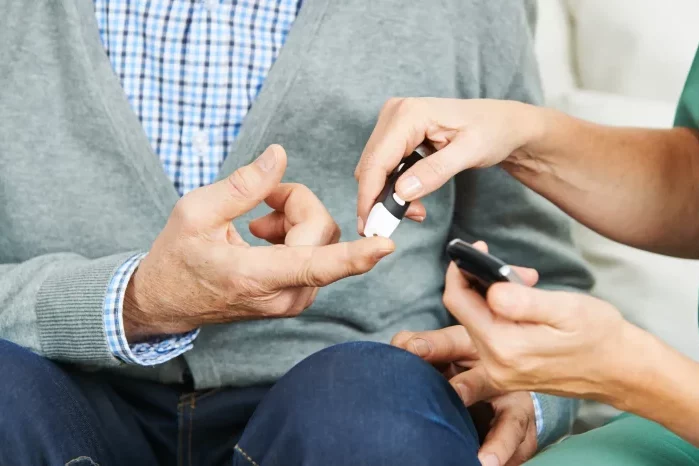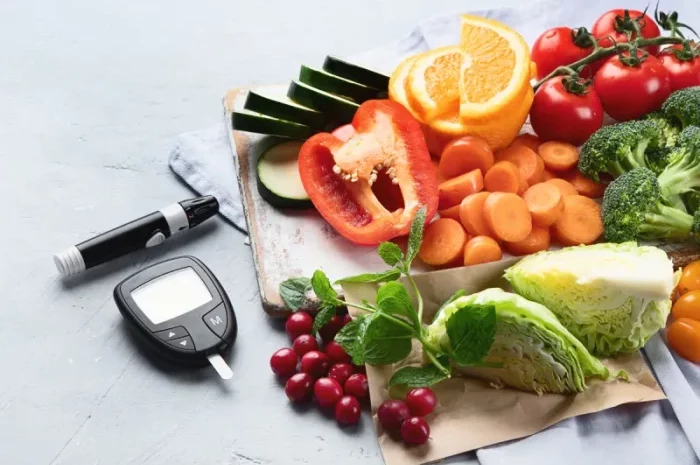Type 2 diabetes is a chronic condition that affects millions of people worldwide. It is characterized by the body’s inability to regulate blood sugar levels effectively, leading to a range of health complications. However, through careful management of diet and exercise, individuals with type 2 diabetes can significantly improve their health outcomes. This article delves into the nuances of how diet and exercise influence type 2 diabetes, providing a comprehensive guide for those seeking to manage their condition better.
Explanation of Type 2 Diabetes
Defining Type 2 Diabetes
Type 2 diabetes is a metabolic disorder where the body becomes resistant to insulin or the pancreas does not produce enough insulin. Insulin is a hormone that facilitates the uptake of glucose (sugar) from the bloodstream into the cells for energy production. When insulin function is impaired, glucose accumulates in the blood, leading to hyperglycemia (high blood sugar levels).
How It Affects the Body’s Ability to Regulate Blood Sugar
In type 2 diabetes, the body’s cells become less responsive to insulin, a condition known as insulin resistance. The pancreas compensates by producing more insulin, but over time, it cannot keep up, leading to insufficient insulin levels. This imbalance causes blood sugar levels to rise, resulting in various symptoms such as increased thirst, frequent urination, fatigue, and blurred vision. Chronic high blood sugar can damage blood vessels, nerves, and organs, leading to complications like heart disease, kidney failure, neuropathy, and retinopathy.
Role of Diet in Managing Type 2 Diabetes
Diet plays a crucial role in managing type 2 diabetes. By making mindful dietary choices, individuals can regulate their blood sugar levels, manage their weight, and reduce the risk of complications.
Impact of Dietary Choices on Blood Sugar Levels
Certain foods can cause blood sugar levels to spike, while others can help maintain stable glucose levels. Understanding how different foods affect blood sugar is essential for effective diabetes management.
Importance of Eating a Balanced Diet Rich in Fruits, Vegetables, and Whole Grains
A balanced diet rich in fruits, vegetables, and whole grains provides essential nutrients while helping to control blood sugar levels. These foods are high in fiber, which slows the absorption of sugar into the bloodstream, preventing rapid spikes in blood sugar.
Fruits and Vegetables: These are rich in vitamins, minerals, and antioxidants. Non-starchy vegetables, such as leafy greens, broccoli, and peppers, have a low impact on blood sugar levels and are excellent choices.
Whole Grains: Whole grains like brown rice, quinoa, and oats are high in fiber and have a lower glycemic index than refined grains, making them better for blood sugar control.
Limiting Intake of Sugary and Processed Foods
Sugary and processed foods can cause rapid spikes in blood sugar levels and should be limited. These foods often contain high amounts of added sugars and unhealthy fats, contributing to weight gain and increased insulin resistance.
Sugary Foods: Foods and beverages high in added sugars, such as sodas, candies, and baked goods, should be consumed sparingly.
Processed Foods: Processed foods often contain refined carbohydrates, unhealthy fats, and added sugars. Examples include white bread, pastries, and many snack foods.
Understanding the Glycemic Index and Glycemic Load of Foods
The glycemic index (GI) measures how quickly a food raises blood sugar levels. Foods with a high GI cause rapid spikes, while those with a low GI result in slower, more gradual increases. The glycemic load (GL) considers both the GI and the
amount of carbohydrates in a serving of food, providing a more comprehensive picture of a food’s impact on blood sugar.
Low-GI Foods: Foods like lentils, beans, and most vegetables have a low GI and are beneficial for blood sugar control.
High-GI Foods: Foods such as white bread, sugary cereals, and certain fruits like watermelon have a high GI and should be eaten in moderation.
By focusing on low-GI foods and understanding the GL of various foods, individuals can make better dietary choices to manage their blood sugar levels effectively.
Role of Exercise in Managing Type 2 Diabetes
Exercise is a cornerstone of type 2 diabetes management. It helps improve insulin sensitivity, lower blood glucose levels, and promote overall health.
Improving Insulin Sensitivity and Lowering Blood Glucose Levels
Regular physical activity enhances the body’s sensitivity to insulin, allowing cells to use glucose more effectively. This results in lower blood sugar levels and reduces the burden on the pancreas.
Different Forms of Exercise
Various types of exercise can benefit individuals with type 2 diabetes, including aerobic exercise, resistance training, and flexibility exercises.
Aerobic Exercise
Aerobic exercise, also known as cardiovascular exercise, involves activities that increase the heart rate and breathing. Examples include walking, jogging, swimming, and cycling. Aerobic exercise helps lower blood sugar levels and improve cardiovascular health.
Benefits: Regular aerobic exercise improves insulin sensitivity, aids in weight loss, and reduces the risk of heart disease.
Guidelines: The American Diabetes Association recommends at least 150 minutes of moderate-intensity aerobic exercise per week, spread over at least three days, with no more than two consecutive days without exercise.
Resistance Training
Resistance training, or strength training, involves exercises that build muscle mass and strength. Examples include weight lifting, resistance band exercises, and body-weight exercises like push-ups and squats.
Benefits: Increased muscle mass enhances glucose uptake by muscles, improving blood sugar control. It also boosts metabolism and supports weight management.
Guidelines: It is recommended to perform resistance training at least two to three times per week, targeting all major muscle groups.
Flexibility and Balance Exercises
Flexibility and balance exercises, such as yoga and tai chi, can improve overall fitness and well-being. These exercises are particularly beneficial for older adults to maintain mobility and prevent falls.
Benefits: Improved flexibility and balance can enhance physical function and reduce stress levels.
Guidelines: Incorporating flexibility and balance exercises several times a week can complement aerobic and resistance training.
Practical Tips for Diet and Exercise
Incorporating healthy eating and regular physical activity into daily routines can be challenging but is essential for managing type 2 diabetes effectively.
Dietary Tips
Plan Your Meals: Planning meals ahead of time can help ensure a balanced diet and prevent unhealthy choices.
Portion Control: Be mindful of portion sizes to avoid overeating, which can lead to blood sugar spikes.
Healthy Snacking: Choose healthy snacks like fruits, vegetables, nuts, and seeds instead of sugary or processed snacks.
Stay Hydrated: Drink plenty of water throughout the day to stay hydrated and avoid sugary beverages.
Read Labels: Check food labels for added sugars and unhealthy fats. Aim for foods with lower GI and GL values.
Exercise Tips
Set Realistic Goals: Start with achievable goals and gradually increase the intensity and duration of exercise.
Find Activities You Enjoy: Choose exercises that you find enjoyable to stay motivated and consistent.
Incorporate Physical Activity into Daily Routine: Use the stairs instead of the elevator, walk or cycle for short trips, and take breaks to stretch during long periods of sitting.
Use Technology: Utilize fitness apps or devices to track physical activity and set reminders for workouts.
Stay Consistent: Consistency is key to reaping the benefits of exercise. Make it a regular part of your routine.
Benefits of Lifestyle Changes
Adopting a healthy lifestyle through diet and exercise offers numerous benefits for individuals with type 2 diabetes.
Improved Blood Sugar Control
Regular exercise and a balanced diet can help maintain stable blood sugar levels, reducing the risk of hyperglycemia and hypoglycemia.
Weight Loss
Weight loss, particularly in individuals who are overweight or obese, can significantly improve insulin sensitivity and reduce blood sugar levels.
Reduced Risk of Diabetes-Related Complications
Healthy lifestyle changes can lower the risk of complications such as heart disease, kidney disease, neuropathy, and retinopathy.
Enhanced Quality of Life
Improved energy levels, better mood, and increased physical fitness contribute to a higher quality of life and overall well-being.
Medical Guidance and Monitoring
While diet and exercise are crucial components of type 2 diabetes management, it is essential to consult healthcare professionals for personalized advice and monitoring.
Consulting Healthcare Professionals
Healthcare providers can offer tailored recommendations based on an individual’s specific needs, medical history, and current health status.
Dietitians: A registered dietitian can help create a personalized meal plan that meets nutritional needs and supports blood sugar control.
Exercise Specialists: A physical therapist or certified fitness trainer can develop a safe and effective exercise program.
Doctors: Regular check-ups with a doctor are important to monitor blood sugar levels, adjust medications if necessary, and screen for complications.
Monitoring Progress
Regular monitoring of blood sugar levels, weight, and other health markers is crucial for managing type 2 diabetes effectively.
Self-Monitoring: Use a blood glucose meter to check blood sugar levels regularly, and keep a record to track trends.
Regular Check-Ups: Schedule regular visits with healthcare providers to review progress and make necessary adjustments to the treatment plan.
Conclusion
Managing type 2 diabetes requires a multifaceted approach that includes a healthy diet, regular exercise, and ongoing medical guidance. By making informed dietary choices, engaging in various forms of physical activity, and working closely with healthcare professionals, individuals with type 2 diabetes can achieve better blood sugar control, improve their overall health, and reduce the risk of complications. Embracing these lifestyle changes can lead to a more active, fulfilling life and greater well-being.
Related Topics


























